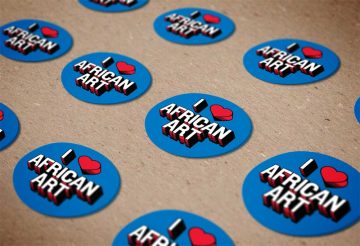
Home | That Liberty and Equality Might Yet Reign | Legends—Looking Back, Facing Forward | Divine Endurance: Ethiopia | Our Ancestors Lived Free | We Are…: Women Warriors | A Long Walk to Freedom: South Africa | Independent Africa Faces Forward
Our Ancestors Lived Free
“I salute you all, sons of Mali . . . I have come back, and as long as I breathe, Mali will never be in thrall—rather death than slavery. We will live free because our ancestors lived free.”
—Sundiata Keita, in D.T. Niane, Sundiata: An Epic of Old Mali
Ogoni artist
Hero in History: Ken Saro-Wiwa
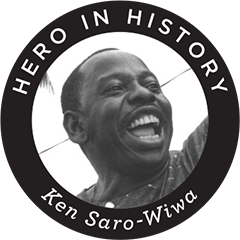
- Alternately a writer, television producer, professor, and civil servant, Saro-Wiwa turned to activism as global oil companies’ environmental damage to Ogoniland grew.
- Saro-Wiwa helped found the Movement for the Survival of the Ogoni People (MOSOP) to bring global attention to the destruction of the Niger Delta—still one of the earth’s most polluted places.
- Saro-Wiwa and eight other Ogoni leaders were summarily arrested and executed in 1995 by the military dictator ruling Nigeria.
- As a martyr, Saro-Wiwa’s voice grew exponentially. Nigeria was suspended from the Commonwealth of Nations until the return of democracy.
The writer cannot be a mere storyteller; he cannot be a mere teacher; he cannot merely X-ray society’s weaknesses, its ills, its perils. He or she must be actively involved shaping its present and its future.”
—Ken Saro-Wiwa, source, dateI am more dangerous dead.
—Ken Saro-Wiwa, source, dateEdo artists

Benin, Edo State, Nigeria
Mask (odudua)
18th century
Copper alloy, iron
Gift of Walt Disney World Co., a subsidiary of The Walt Disney Company, 2005-6-2
Hero in History: Oba Ewuakpe I

- Ewuakpe I came to the throne after a period of crises around the issue of royal succession. Initially quite unpopular, he was driven out of the palace by the people of Benin.
- Only through the self-sacrifice of his devoted wife, Iden, did Ewuakpe I regain spiritual authority. He reclaimed political authority by ending a law that transferred Edo chiefs’ properties to the king upon their deaths.
- Ewuakpe I instituted a system whereby the title of oba (king) passed to the first-born son, smoothing periods of dynastic conflict and ensuring the continuity of the monarchy.
Iyase̩ lend me twenty cowries
Esọgban lend me twenty cowries
Esọn lend me twenty cowries
To buy a basket and a bag
For marketing in the Agbado market.
—Song Ewuakpe I played on his harp during his exile, showing his dependence on the other titled members of the Royal Executive Council
El Anatsui
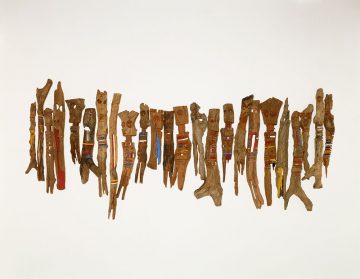
b. 1944, Anyako, Volta Region, Ghana
Works in Nsukka, Enugu State, Nigeria
The Ancestors Converged Again
1995
Wood, tempera
Purchased with funds provided by the Annie Laurie Aitken Endowment, 98-11-1
Heroes in History: Ghana’s “Big Six” Independence Leaders
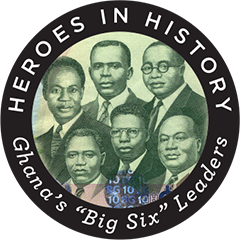
They organized Ghana’s first political party, channeling constructive impatience into a campaign for independence.
- The ‘Big Six’ were the leaders of the United Gold Coast Convention (UGCC), a political party founded by J.B. Danquah in 1947 to push for self-government.
- On Feb. 28, 1948, a peaceful demonstration in Accra for pay owed by veterans who fought for Britain in World War II was met with gunfire, killing three people. Horrified by the incident, the ‘Big Six’ called for full and immediate self-rule. They were all arrested.
- In prison, the group earned their collective nickname, and became a symbol for the country’s self-determination. One—Kwame Nkrumah—would use the added notoriety to build a new political party, which would eventually carry him to power.
“...Unless Colonial Government is changed and a new Government of the people and their Chiefs installed at the centre immediately, the conduct of masses now completely out of control with strikes…will continue…Working Committee United Gold Coast Convention declare they are prepared and ready to take over interim Government. We ask in name of oppressed, inarticulate, misruled and misgoverned people and their Chiefs that Special Commissioner be sent out immediately to hand over Government to interim Government of Chief and People and to witness immediate calling of Constituent Assembly.”
—Telegram from United Gold Convention leaders (Accra) to Secretary of State (London), Feb. 28, 1948Possibly Bvu Kwam
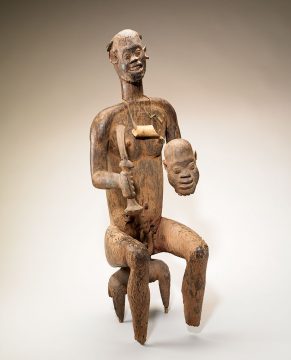
Active early 19th century, Isu kingdom, Grassfields region, Cameroon
Figure of King Bay Akiy
Early 19th century
Wood, ivory, pigment, human hair, bone, cloth
Gift of Walt Disney World Co., a subsidiary of The Walt Disney Company, 2005-6-31
This masterpiece has an unusually emotional expression that may be associated with the personal style of Bvu Kwam, an early 19th-century master sculptor working in the Grassfields region. According to one field informant, the figure is of King Bay Akiy, the fourth ruler of the Isu kingdom, who reigned in the late 18th century. Depicted returning from victory over the Nshe, a neighboring group, he is seated on a dangerous animal, probably a leopard, and holds a weapon and a head. This pose relates to a regional tradition of representing personal achievement, though the identity of the head itself is uncertain—it could be a defeated enemy, or the revered skull of a local ancestor.
Hero in History: Ibrahim Njoya

- The 17th fon (king) of Bamum; Njoya’s rule (1877—1923) overlapped with German colonial occupation.
- A skilled diplomat, Njoya shrewdly negotiated autonomy for his kingdom from the Germans—including through the gift of art works to the Kaiser in Berlin.
- Njoya created an innovative new script for the Bamum language, and was a leader in efforts to preserve Bamum culture.
- Despite the German colonial presence, Njoya used deft diplomacy and canny cultural policies to build a legacy that outlasted the occupiers.

Urhobo artist

Delta or Bayelsa State, Nigeria
Female figure of an ancestor (edjo)
Late 19th to early 20th century
Wood, pigment, kaolin
Museum purchase, 97-17-1
Heroes in History: Blessing Okagbare
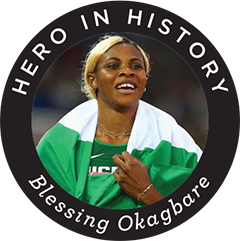
- Born to an Urhobo family, Okagbare is a track-and-field athlete specializing in sprints and the long jump. She won a bronze medal at the 2008 Beijing Olympics when she was 19.
- She has medaled consistently in World Championships, Commonwealth Games, and the African Games in the past decade.
- Okagbare holds the Commonwealth Games women’s record—10.85 seconds—in the 100m dash and is the African record holder—22.04 seconds—in the 200m.
I’m determined to compete on the big stage and prove myself.
—Blessing OkagbareIgbo artists

Abiriba, Abia State, Nigeria
Male figure of an ancestor (ndichie)
Early to mid-20th century
Wood, pigment
Gift of Walt Disney World Co., a subsidiary of The Walt Disney Company, 2005-6-81
Heroes in History: Chinua Achebe

- Africa’s most widely read and celebrated novelist, Achebe cemented his reputation with Things Fall Apart (1958), which sold more than 10 million copies and has been translated into more than 50 languages.
- Writing from an unabashedly specific, African point of view, Achebe’s novels critiqued both colonial arrogance and the failures of postcolonial governments.
- In his lifetime, Achebe was granted more than 30 honorary degrees from universities in the United States, Europe, and Africa and awarded the Man Booker International Prize as well as honorary membership in the American Academy of Arts and Sciences and the Nigerian National Order of Merit.
If you don’t like someone’s story, write your own.
—Chinua Achebe, interview in The Paris Review, 1994Storytellers are a threat. They threaten all champions of control, they frighten usurpers of the right-to freedom of the human spirit—in state, in church or mosque, in party congress, in the university or wherever.
—Chinua Achebe, Anthills of the SavannahAkan artist

Eastern or Ashanti Region, Ghana
Commemorative head (nsodie)
Late 19th century
Ceramic
Gift of Walt Disney World Co., a subsidiary of The Walt Disney Company, 2005-6-163
Heroes in History: Yaa Asantewaa
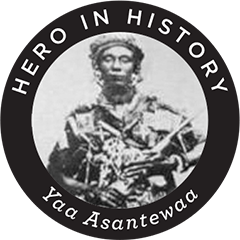
- The queen mother of Ejisu, Yaa Asantewaa, became regent of Ejisu, a chiefdom of the Asante Empire, when the British exiled her son, its ruler, and the asantehene (king), Prempeh I, in 1896.
- In a foolish act of hubris in 1900, the British governor demanded the Golden Stool—the spiritual and symbolic heart of the Asante nation—which had been hidden since the exile. With the backing of the remaining Asante leaders, Yaa Asantewaa became the leader of the Asante fighting force.
- The Yaa Asantewaa War forced a small party of British invaders in the Asante capital of Kumasi into a six-month siege as Asante warriors held them at bay.
- Captured and exiled, Yaa Asantewaa passed away three years before Prempeh I returned to Kumasi in 1924. The British never touched the Golden Stool.
Now I have seen that some of you fear to go forward to fight for our king . . . Is it true that the bravery of the Asante is no more? I cannot believe it. It cannot be! I must say this—if you, the men of Asante, will not go forward, then we will. We, the women, will. I shall call upon my fellow women. We will fight the white men. We will fight until the last of us fall in the battlefields.
—Yaa Asantewaa, March 1900Fang artist
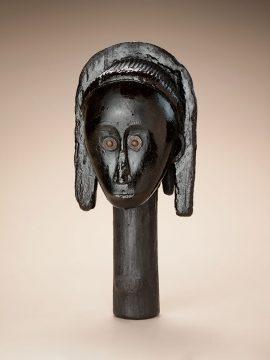
Gabon
Reliquary guardian head (eyema bieri)
Late 19th or early 20th century
Wood, metal, oil
Gift of Walt Disney World Co., a subsidiary of The Walt Disney Company, 2005-6-98
Hero in History: Jean-Hilaire Aubame

- During World War II, Aubame sided with Charles de Gaulle’s Free French and worked to rally fellow Fang peoples to the antifascist cause. He later represented Gabon in the French National Assembly.
- A political rival to the first president of Gabon, Léon Mba, Aubame nevertheless resolved to compromise with Mba in the interest of building the postcolonial state. Aubame was Gabon’s first foreign minister.
- A 1964 military coup against Mba’s increasingly imperious, French-backed rule briefly installed Aubame as president. The French, however, soon intervened and sentenced Aubame to 10 years of hard labor and 10 years exile. In prison, he became a symbol of opposition.

